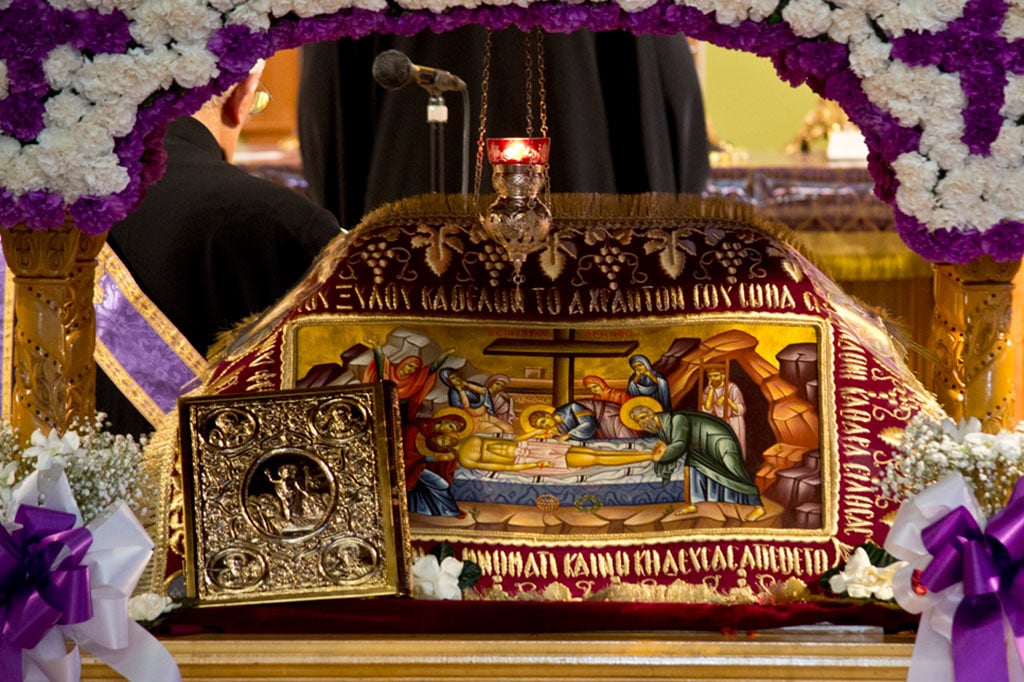In most Slavic languages, the name for Easter either means "Great Day" or "Great Night". For example, Wielkanoc, Veľká noc and Velikonoce mean "Great Night" or "Great Nights" in Polish, Slovak and Czech, respectively. Велигден (Veligden), Великдень (Velykden), Великден (Velikden), and Вялікдзень (Vyalikdzyen') mean "The Great Day" in Macedonian, Ukrainian, Bulgarian, and Belarusian, respectively.
In Serbian, however, the day's name reflects a particular theological connection: it is called Uskrs, meaning "Resurrection". It also explains the fact that in Serbian Easter is sometimes also called Vaskrs, a liturgical form inherited from the Serbian recension of Church Slavonic.
Easter church services are followed by families having their baskets of colored eggs blessed by the parish priest. Usually, the eggs are red symbolizing happiness, joy, rebirth, and the blood of Christ. Families exchange eggs and say, Hristos Voskrese (Christ is risen). The response is Voistinu Voskrese (Indeed He is risen).
Central to the Serbian celebration of Easter is the egg, the seasonal symbol of new life. Easter eggs in Western Europe can be made of chocolate and sold in supermarkets. However, Serbs use ordinary chicken eggs at Easter, boiling scores of them at home on Good Friday.
While the Easter weekend is the climax of the celebration, for many Serbs the festivities start in earnest on Lazar’s Saturday, April 16th. On that day, church floors are covered for the afternoon mass with the flower known as vrbica, or in English, purple loosestrife.
During the ceremony, the priest blesses the flowers and shares them with believers.
This day marks Jesus’ entry into Jerusalem. Vrbica is a Serbian version of the palm fronds that children laid down on Jesus’ path. Believers also make wreaths out of vrbica flowers and place them on their front doors, while children wear little bells around their necks as a symbol of Jesus’ coming.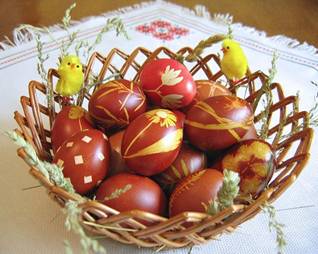 The tradition is dyeing the first set of eggs in red and setting one of them aside until next Easter. That egg is called the housekeeper, referring to the belief that the egg will help protect the home.
The tradition is dyeing the first set of eggs in red and setting one of them aside until next Easter. That egg is called the housekeeper, referring to the belief that the egg will help protect the home.
Although colored dyes for the eggs can be bought in the market, most people still dye at least 10 eggs by boiling them with an onion.
The onion gives the eggs a nice caramel color. And if you want to create a pattern on the egg, just draw on it with wax before boiling.
Although Easter bunnies are becoming more popular, the animal that truly symbolizes Easter for Serbs is the baby chick – the natural product of the egg. Young children often play with stuffed toys of chicks.
After coloring Easter eggs, families traditionally spend the afternoon at mass. The Good Friday Mass is performed in front of a replica of Jesus’ shroud, symbolizing the removal of the body from the cross. In some churches, believers pass under the shroud after the ceremony and make a wish.
Saturday is reserved for decorating homes. Easter Sunday starts with bells ringing in churches throughout the country.
In the Orthodox tradition, believers give up certain foods during the 40 days up to Easter, making Easter Sunday a much-awaited feast.
After morning mass, families have breakfast together and play the game of ‘tucanje’, which involves cracking eggs against each other to see which one breaks first.
Most Serbs spend Easter visiting friends and family. The phrase exchanged most commonly in greeting is “Hristos Vaskrse”, meaning, “Christ is Risen”. The response is Voistinu Voskrese (Indeed He is risen).
It is standard practice to exchange colored eggs between hosts and guests.
tem No. 9781936270590
by Elizabeth Crispina Johnson, illustrated by Daria Fisher
At Pascha, Orthodox all over the world dye and bless red eggs. Here is the story of how this tradition started—way back in apostolic times, with St. Mary Magdalene and a blessed miracle that dazzled the unbelieving Roman emperor with the reality and power of Christ's Resurrection.
Available at the Ancient Faith Bookstore: https://store.ancientfaith.com/the-miracle-of-the-red-egg/
The vigil on the eve of Holy Thursday is dedicated exclusively to the Passover Supper which Christ celebrated with his twelve apostles. The main theme of the day is the meal itself at which Christ commanded that the Passover of the New Covenant be eaten in remembrance of Himself, of His body broken and His blood shed for the remission of sins. In addition, Judas’ betrayal and Christ’s washing of His disciples feet is also central to the liturgical commemoration of the day.
In cathedral churches it is the custom for the bishop to re-enact the foot washing in a special ceremony following the Divine Liturgy. At the vigil of Holy Thursday, the Gospel of Saint Luke about the Lord’s Supper is read. At the Divine Liturgy the Gospel is a composite of all the evangelists’ accounts of the same event. The hymns and the readings of the day also all refer to the same central mystery.
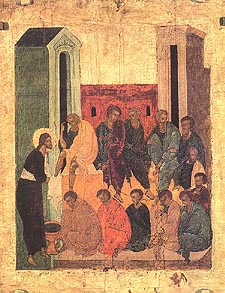
When Thy glorious disciples were enlightened at the washing of their feet before the supper, then the impious Judas was darkened by the disease of avarice, and to the lawless judges he betrayed Thee, the Righteous Judge. Behold, O lover of money, this man because of avarice hanged himself. Flee from the insatiable desire which dared such things against the Master! O Lord who deals righteously with all, glory to Thee (Troparion of Holy Thursday).
In the regions of the Master, at the Table of Immortality, in the high place, with minds lifted up, come, O ye faithful, let us eat with delight (Ninth Ode of the Canon of Matins).
The Divine Liturgy of Saint Basil is served on Holy Thursday in connection with Vespers. The long gospel of the Last Supper is read following the readings from Exodus, Job, Isaiah and the first letter of the Apostle Paul to the Corinthians (1 Cor 11). The following hymn replaces the Cherubic Hymn of the offertory of the liturgy, and serves as well as the Communion and Post-Communion Hymns.
Of Thy mystical supper, O Son of God, accept me today a communicant, for I will not speak of Thy mystery to thine enemies, neither like Judas will I give Thee a kiss, but like the thief will I confess Thee: Remember me, O Lord, in Thy kingdom.
The liturgical celebration of the Lord’s Supper on Holy Thursday is not merely the annual remembrance of the institution of the sacrament of Holy Communion. Indeed the very event of the Passover Meal itself was not merely the last-minute action by the Lord to “institute” the central sacrament of the Christian Faith before His passion and death. On the contrary, the entire mission of Christ, and indeed the very purpose for the creation of the world in the first place, is so that God’s beloved creature, made in His own divine image and likeness, could be in the most intimate communion with Him for eternity, sitting at table with Him, eating and drinking in His unending kingdom. Thus, Christ the Son of God speaks to His apostles at the supper, and to all men who hear His words and believe in Him and the Father who sent Him:
Fear not, little flock, it is Your Father’s good pleasure to give you the kingdom (Lk 12.32).
You are those who have continued with Me in My trials; as My Father appointed a Kingdom for Me, so do I appoint for you that you may eat and drink at My table in My Kingdom . . . (Lk 22.28–31).
In a real sense, therefore, it is true to say that the body broken and the blood spilled spoken of by Christ at His last supper with the disciples was not merely an anticipation and preview of what was yet to come; but that what was yet to come—the cross, the tomb, the resurrection on the third day, the ascension into heaven—came to pass precisely so that men could be blessed by God to be in holy communion with him forever, eating and drinking at the mystical table of His kingdom of which there will be no end.
Thus the “Mystical Supper of the Son of God” which is continually celebrated in the Divine Liturgy of the Christian Church, is the very essence of what life in God’s Kingdom will be for eternity.
Blessed is he who shall eat bread in the Kingdom of God (Lk 14.15).
Blessed are those who are invited to the Marriage Supper of the Lamb (Rev 19.9).
HOLY AND GREAT WEDNESDAY
On Holy and Great Wednesday the divine Fathers ordained a commemoration to be kept of the woman who was a harlot and who anointed the Lord with myrrh, since this took place a short time before the saving Passion.
As Jesus was going up to Jerusalem, when He was in the house of Simon the leper, a woman came and poured most precious myrrh on the head of Christ and wiped His feet with her hair, rendering Him service at a very great cost to herself. This event is set forth here that, according to the Savior's word, her act of great fervor may be proclaimed to everyone everywhere, and because it occurred a short time before the Passion. What moved her to act thus? She had seen how merciful Christ was and how accessible to all; now, in particular, she saw Him enter the house of a leper, whom the Law deemed unclean and unfit for society. She thought to herself that He would heal the man's leprosy and likewise the illness of her own soul. Thus, while He was seated, she poured on the top of His head a quantity of myrrh, which was worth about "three hundred thirteen denarii in silver coin," that is, sixty assaria, and she wiped His feet with her hair. She placed her head at His feet, showing her zeal for repentance, but the disciples rebuked her, particularly Judas Iscariot. Christ, however, welcomed her, not allowing them to frustrate her good intention. He further mentioned His burial, dissuaded Judas from becoming a traitor, and honored the woman by saying that her good deed would be related everywhere, throughout the whole world.
Let it be known that there are two women who anointed the Lord with myrrh, as the divine Chrysostom says. He said that in the three Evangelists there is a certain woman who is also called a harlot, while in Saint John there is another woman, Mary the sister of Lazarus, who was not a harlot but a friend of Christ. Thus, the woman in St. John's Gospel is not the same as the one mentioned by the other Evangelists. Whether both of them anointed Christ on the same day - this is not mentioned. Others, however, assert that there was a third woman: the one who was at the house of Simon the Pharisee; a second, Mary the sister of Lazarus; and a third woman, a different one who was at the supper. Although this opinion is added as a supplement, it is not known whether it can be held as accurate, since one of these women is not she who is now set before us.
That nard, or rather myrrh, with which the harlot anointed Christ, was very costly. It belonged to that type of compound called myrrh, which Moses was commanded by God to make for the anointing of priests and chief priests. It is of this that David says, "It is like the precious oil on the head, running down to the beard, to Aaron's beard, running down to the edge of his garment" (Ps. 132:2). It was a compound of four substances: myrrh, flowers, fragrant cinnamon, and oil. It was called true or genuine, because skilled and trusted men were appointed to prepare that which God had in a mysterious manner revealed to Moses alone. An alabaster jar is a glass vessel made with no handle, which is also called a vykion.
We should know that today the deceitful Judas, that lover of money, that whelp of Satan, began the negotiations with the wicked Sanhedrin to betray the Master for thirty pieces of silver. Being indignant after Christ rebuked him for showing concern for the cost of the oil of myrrh, he sought out the Jews who were at the court of Caiaphas. After taking council with the Jewish High Priests, he searched for an opportunity to betray the Lord when He was alone, for the Sanhedrin feared the multitude that followed Christ.
We see in today's Gospel (Matt. 26:6-16) that the sinful woman brought oil of myrrh to anoint Christ, while Judas brought his greed to the Sanhedrin. She spread out her hair to wipe the Lord's feet, while Judas stretched out his hands for the money. She rejoiced to pour out the very precious oil on the Lord, while Judas made plans to sell the One who is above all price. By anointing Christ, she acknowledged Him as Lord, while Judas severed himself from the Master. She was set free of her sins, while Judas was entrapped and became a slave of the devil. She tenderly kissed the feet of Christ, asking for forgiveness, while Judas plotted to betray the Lord with a kiss, anticipating the silver.
Because the betrayal of Christ occurred on a Wednesday, the Orthodox Church has received the tradition from Apostolic times to observe Wednesday as a fast day throughout the entire year.
O Christ our God, Who was anointed with the noetic myrrh, have mercy on us and save us. Amen.
Kontakion, Tone 4
Though I have transgressed, O Good One,
more than the harlot,
I have never offered Thee a flood of tears.
but, praying in silence,
I fall down before Thee,
with love embracing Thy most pure feet,
that Thou as Master mayest grant me remission of sins.
And I cry to Thee, O Saviour:
Deliver me from the defilement of my evil deeds.
Ikos: Having come to hate the works of sin and carnal pleasure, the woman who before had been a prodigal became chaste at once. Calling to mind the magnitude of disgrace and the condemnation of torment which harlots and profligates, of whom I am first, shall endure, I also am afraid; yet I foolishly continue in my evil ways. But the woman who was a harlot, having been filled with fear, hastened quickly to the Deliverer, crying out: "O compassionate Lord who lovest mankind, deliver me from the defilement of my evil deeds."
The Exapostilarion (The Hymn of Light)
Thy bridal chamber, O my Savior, I see adorned,
and I have no raiment with which to enter therein.
Enlighten the garment of my soul, O Giver of Light, and save me.
The Hymn of Cassia
O Lord, the woman who had fallen into many sins,
perceiving Thy divinity,
became one of the Myrrhbearers,
bringing Thee ointment in tears before Thy burial.
She cried, "Woe is me!
"For I lived in a night of licentiousness,
"moonless and dismal love of sin.
"Accept the fount of my tears,
"O Thou who drawest the waters of the sea from the clouds.
"Bow down Thine ear to the sighing of my heart,
"O Thou who didst bow the heavens in Thine ineffable self-emptying,
"that I may kiss Thy most pure feet
"and wipe them again with the hairs of my head,
"the feet whose step Eve once heard in Paradise in the cool of the day,
"when for fear she hid herself.
"My sins are many. And who may search the depths of Thy judgments?
"O Saviour of souls, my Saviour,
"despise not Thy servant
"in Thy limitless mercy."
Easter eggs are special eggs that are often given to celebrate Easter. The egg is seen as a symbol of resurrection: while being dormant it contains a new life sealed within it.
Easter eggs are dyed red to represent the blood of Christ, shed on the Cross, and the hard shell of the egg symbolizes the sealed Tomb of Christ — the cracking of which symbolizes His resurrection from the dead. Easter eggs are blessed by the priest at the end of the Paschal Vigil (which is equivalent to Holy Saturday), and distributed to the faithful. Each household also brings an Easter basket to church, filled not only with Easter eggs but also with other Paschal foods such as paskha, kulich, or Easter breads, and these are blessed by the priest as well.
While the origin of easter eggs can be explained in the symbolic terms described above, a sacred tradition among followers of Eastern Christianity says that Mary Magdalene brought cooked eggs to share with the other women at the tomb of Jesus, and the eggs in her basket miraculously turned brilliant red when she saw the risen Christ. The egg represents the boulder of the tomb of Jesus.[3]
A different, but not necessarily conflicting legend concerns Mary Magdalene's efforts to spread the Gospel. According to this tradition, after the Ascension of Jesus, Mary went to the Emperor of Rome and greeted him with "Christ has risen," whereupon he pointed to an egg on his table and stated, "Christ has no more risen than that egg is red." After making this statement it is said the egg immediately turned blood red.
Lazarus Saturday and Palm Sunday
Immediately after the end of the forty days of penitence and before the days of darkness and mourning of Passion Week, the Holy Church celebrates the bright festivals of Lazarus Saturday and Palm Sunday. Lazarus Saturday commemorates the raising of Lazarus from the dead and serves as a reminder that Jesus is the Master of life and death, and foreshadows the Lord's glorious Resurrection eight days later. Palm Sunday, of course, commemorates Our Lord's glorious entrance into Jerusalem. On this day Palm branches are blessed and held by the faithful (pussy-willow branches in the Russian Church) in remembrance of that joyous day.
Holy Monday, Tuesday, and Wednesday
The next three days (Holy Monday, Tuesday and Wednesday) are characterized by the beautiful and moving melody sung at Matins, Behold, the Bridegroom comes as midnight..., for which reason the Matins of these three days is called Bridegroom Matins. The theme is taken from the Parable of the Ten Virgins (Matt. 25:1-13) and serves to remind us of the urgency of the End it is near at hand and we must be watchful and repent while there is still time.
Holy Thursday
On this day we commemorate the washing of the disciple's feet, the institution of the Holy Eucharist (the Last Supper), the agony in the Garden of Gethsemane, and the betrayal of Christ by Judas. In certain cathedrals and monasteries a special Service is celebrated in which the Bishop (or Abbot), taking the place of Christ, washes the feet of twelve Priests, representing the Twelve Apostles. In addition, the Holy Chrism is consecrated on this day by the various Patriarchates and Autocephalous Churches.
Holy Friday
On this day we commemorate Christ's suffering and death. The Matins Service is characterized by the reading of the Twelve Passion Gospels which relate events connected with the final hours from the Last Supper to the Lord's Crucifixion, Death and Burial. That morning the more solemn Royal Hours are said, and at the Vespers Service sung that afternoon, the Burial Shroud (Russian Plaschanitsa; Greek Epitaphion) is brought out in a solemn procession and placed in a specially-prepared place (the Grave) for veneration. On this day neither the full Liturgy (except if the Feast of the Annunciation falls on this day) nor that of the Presanctified Gifts is celebrated.
Holy Saturday
On this day we commemorate the burial of Christ and His descent into Hell. At the Matins Lamentations Service the Praises are sung before the Burial Shroud in the center of the church and culminates in a solemn procession with the Holy Shroud around the church. On Holy Saturday (according to the Typikon, at 4:00 p.m.), the Vespers with the Liturgy of St. Basil is celebrated with the reading of fifteen Old Testament lessons which refer to Passover, the Resurrection and Baptism. At this time the liturgical vestments and furnishings are changed to white. [Here we must remember that in the ancient Church the Catechumens were baptized on this day, which accounts for the singing of As many as have been baptized into Christ... instead of the Trisagion at the Liturgy, and the changing of the liturgical colors to white the Baptismal colors.]
At the conclusion of the Service (which in ancient times ended about 8:00 p.m.) the Faithful assemble in the now-darkened church for the reading of the Acts of the Apostles. Shortly before Midnight, the Resurrection Nocturns is sung and all of the lights are extinguished. The faithful wait in silence for the moment when the Priest will come out of the Altar with a lit candle, symbolizing the Light of the Risen Christ and the beginning of the Holy Pascha of the Lord the Feasts of Feasts.
Holy Pascha
At the stroke of Midnight, the clergy come out of the Holy Altar, all of the candles are lit, and a joyous, festive procession circles the church three times with the singing of the hymn: Thy Resurrection, O Christ our Savior, the angels in heaven sing. Enable us on earth to glorify Thee in purity of heart. Stopping before the closed outer doors of the church, the Priest exclaims the Paschal verses, Let God arise..., while the Faithful sing the triumphant Paschal hymn, Christ is risen from the dead, trampling down death by death, and upon those in the tombs bestowing life.
The Clergy and Faithful now re-enter the church and the singing of the Paschal Canon, This is the Day of Resurrection..., with numerous repetitions of the Paschal hymn, Christ is risen..., begins. At many points during the Service the Clergy exclaim, Christ is risen! and the Faithful respond, Indeed, He is risen! The church is filled with the Faithful holding lit candles and the Clergy in bright vestments. At the conclusion of the Matins, the catechetical address of St. John Chrysostom is read, summoning all, even those who have come only at the eleventh hour, to the great Paschal Banquet. Matins is then followed by the Paschal Liturgy.
Today He who hung the earth upon the waters is hung upon the Cross. He who is King of the angels is arrayed in a crown of thorns. He who wraps the heavens in clouds is wrapped in the purple of mockery. He who in Jordan set Adam free receives blows upon His face. The Bridegroom of the Church is transfixed with nails. The Son of the Virgin is pierced with a spear. We venerate Thy Passion, O Christ. Show us also Thy glorious Resurrection.
(15th Antiphon of the Matins of Holy Friday)
On Great and Holy Friday the Orthodox Church commemorates the death of Christ on the Cross. This is the culmination of the observance of His Passion by which our Lord suffered and died for our sins. This commemoration begins on Thursday evening with the Matins of Holy Friday and concludes with a Vespers on Friday afternoon that observes the unnailing of Christ from the Cross and the placement of His body in the tomb.
Commemoration of Great and Holy Friday
On this day we commemorate the sufferings of Christ: the mockery, the crown of thorns, the scourging, the nails, the thirst, the vinegar and gall, the cry of desolation, and all the Savior endured on the Cross.
The day of Christ's death is the day of sin. The sin which polluted God's creation from the breaking dawn of time reached its frightful climax on the hill of Golgotha. There, sin and evil, destruction and death came into their own. Ungodly men had Him nailed to the Cross, in order to destroy Him. However, His death condemned irrevocably the fallen world by revealing its true and abnormal nature.
In Christ, who is the New Adam, there is no sin. And, therefore, there is no death. He accepted death because He assumed the whole tragedy of our life. He chose to pour His life into death, in order to destroy it; and in order to break the hold of evil. His death is the final and ultimate revelation of His perfect obedience and love. He suffered for us the excruciating pain of absolute solitude and alienation - "My God, my God, why hast Thou forsaken Me!" (Mark 15:34). Then, He accepted the ultimate horror of death with the agonizing cry, "It is finished" (John 19:30). His cry was at one and the same time an indication that He was in control of His death and that His work of redemption was accomplished, finished, fulfilled. How strange! While our death is radical unfulfillment, His is total fulfillment.
The day of Christ's death has become our true birthday. "Within the mystery of Christ dead and resurrected, death acquires positive value. Even if physical, biological death still appears to reign, it is no longer the final stage in a long destructive process. It has become the indispensable doorway, as well as the sure sign of our ultimate Pascha, our passage from death to life, rather than from life to death.
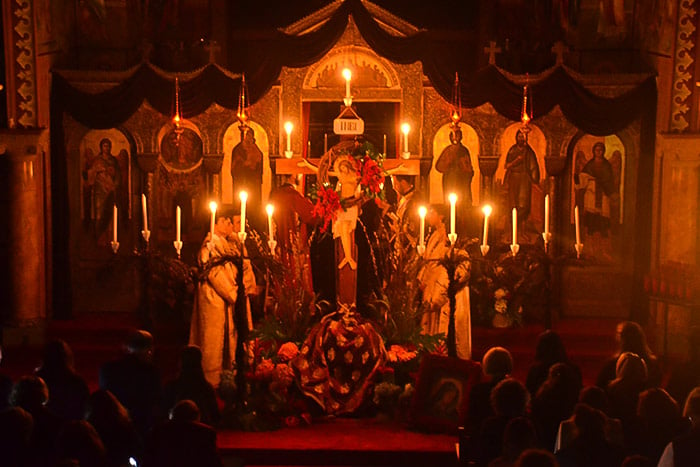 From the beginning the Church observed an annual commemoration of the decisive and crucial three days of sacred history, i.e., Great Friday, Great Saturday and Pascha. Great Friday and Saturday have been observed as days of deep sorrow and strict fast from Christian antiquity.
From the beginning the Church observed an annual commemoration of the decisive and crucial three days of sacred history, i.e., Great Friday, Great Saturday and Pascha. Great Friday and Saturday have been observed as days of deep sorrow and strict fast from Christian antiquity.
Great Friday and Saturday direct our attention to the trial, crucifixion, death and burial of Christ. We are placed within the awesome mystery of the extreme humility of our suffering God. Therefore, these days are at once days of deep gloom as well as watchful expectation. The Author of life is at work transforming death into life: "Come, let us see our Life lying in the tomb, that he may give life to those that in their tombs lie dead" (Sticheron of Great Saturday Orthros).
Liturgically, the profound and awesome event of the death and burial of God in the flesh is marked by a particular kind of silence, i.e. by the absence of a eucharistic celebration. Great Friday and Great Saturday are the only two days of the year when no eucharistic assembly is held. However, before the twelfth century it was the custom to celebrate the Liturgy of the Pre-Sanctified Gifts on Great Friday.
The divine services of Great Friday with the richness of their ample Scripture lessons, superb hymnography and vivid liturgical actions bring the passion of Christ and its cosmic significance into sharp focus. The hymns of the services on this day help us to see how the Church understands and celebrates the awesome mystery of Christ's passion and death.
Icon of the Commemoration of Great and Holy Friday
![]() On Great and Holy Friday, Orthodox churches display the icon known as the "Axra Tapeinosis - The Extreme Humility." This icon depicts the crucified dead body of Christ upright in the Tomb with the Cross in the background. It combines the two awesome events of Great Friday - the crucifixion and burial of Christ.
On Great and Holy Friday, Orthodox churches display the icon known as the "Axra Tapeinosis - The Extreme Humility." This icon depicts the crucified dead body of Christ upright in the Tomb with the Cross in the background. It combines the two awesome events of Great Friday - the crucifixion and burial of Christ.
The Church also has an icon of the Crucifixion of Christ. He is shown nailed to the Cross. His right side is pierced and from the wound flows blood and water. At the foot of the Cross is a skull. (Golgotha, the Mount of the Crucifixion, means "the place of the skull.") Tradition related that the Cross of Christ stood directly over the grave of our Forefather Adam. On the top bar of the Cross is the inscription "I.N.B.I.", the initials for the Greek words meaning "Jesus of Nazareth, King of the Jews." To the left of Christ, the Theotokos and St. Mary Magdalene are often pictured as well; the youthful St. John the Beloved Disciple and St. Longinus the Centurion (Mark 15:39) are shown to the right if they are depicted.
Another icon that depicts the events of Holy Friday is known as the Epitaphios Thrinos. In this icon, Christ has been taken off of the Cross, and His body is being prepared for burial. Shown around the body and mourning His death are His mother, the Theotokos and Virgin Mary, John the beloved disciple, Joseph of Arimathea, and Mary Magdelene.
In addition to these icons, Orthodox churches process with and display a large wooden Crucifix with an image of Christ attached. At the Vespers on Friday, the image of Christ is removed from the Cross and wrapped in a white cloth. Another icon, one that depicts the body of Christ removed from the Cross, appears on the Epitaphios that is carried and placed in the Tomb during this service.
Orthodox Celebration of Great And Holy Friday
The commemorations of Holy Friday begin with the Matins service of the day which is conducted on Thursday evening. The service is a very unique Matins service with twelve Gospel readings that begin with Christ's discourse at the Last Supper and end with the account of His burial: John 13:31-18:1, John 18:1-29, Matthew 26:57-75, John 18:28 - 19:16, Matthew 27:3-32, Mark 15:16-32, Matthew 27:33-54, Luke 23:32-49, John 19:38-42, Mark 15:43-47, John 19:38-42, Matthew 27:62-66
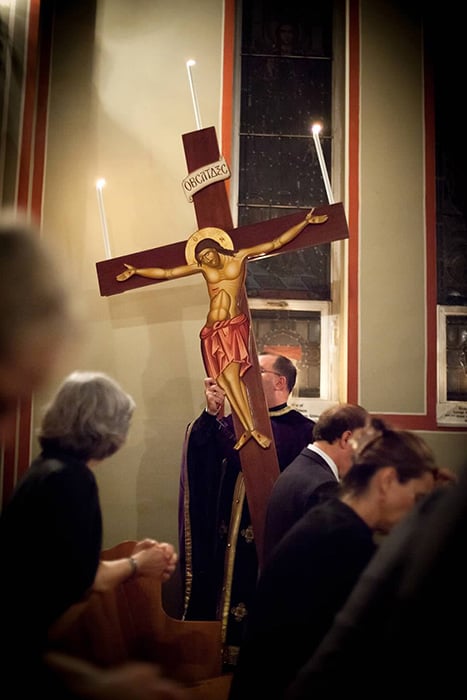 These readings relate the last instructions of Christ to His disciples, the prophecy of the drama of the Cross, the dramatic prayer of Christ and His new commandment. After the reading of the fifth Gospel comes the procession with the Crucifix around the church, while the priest chants the Fifteenth Antiphon:
These readings relate the last instructions of Christ to His disciples, the prophecy of the drama of the Cross, the dramatic prayer of Christ and His new commandment. After the reading of the fifth Gospel comes the procession with the Crucifix around the church, while the priest chants the Fifteenth Antiphon:
"Today is hung upon the Tree, He Who did hang the land in the midst of the waters. A Crown of thorns crowns Him Who is King of Angels. He is wrapped about with the purple of mockery Who wrapped the Heavens with clouds. He received buffetings Who freed Adam in Jordan. He was transfixed with nails Who is the Bridegroom of the Church. He was pierced with a spear Who is the Son of the Virgin. We worship Thy Passion, O Christ. Show also unto us thy glorious Resurrection."
During the Procession, Orthodox Christians kneel and venerate the Cross and pray for their spiritual well-being, imitating the thief on the Cross who confessed his faith and devotion to Christ. The faithful then approach and reverently kiss the Crucifix which has been placed at the front of the church.
On Friday morning, the services of the Royal Hours are observed. These services are primarily readings of prayers, hymns, and passages from the Old Testament, Epistles, and Gospels. The Scripture readings for these services are: First Hour: Zechariah 11:10-13, Galatians 6:14-18, Matthew 27:1-56; Third Hour: Isaiah 50:4-11, Romans 5:6-10, Mark 15:6-41; Sixth Hour: Isaiah 52:13-54:1, Hebrews 2:11-18; Luke 23:32-49; Ninth Hour: Jeremiah 11:18-23,12:1-5,9-11,14-15, Hebrews 10:19-31, John 18:28-19:37.
The Vespers of Friday afternoon are a continuation of the Royal Hours. During this service, the removal of the Body of Christ from the Cross is commemorated with a sense of mourning. Once more, excerpts from the Old Testament are read together with hymns, and again the entire story is related, followed by the removal of Christ from the Cross and the wrapping of His body with a white sheet as did Joseph of Arimathea.
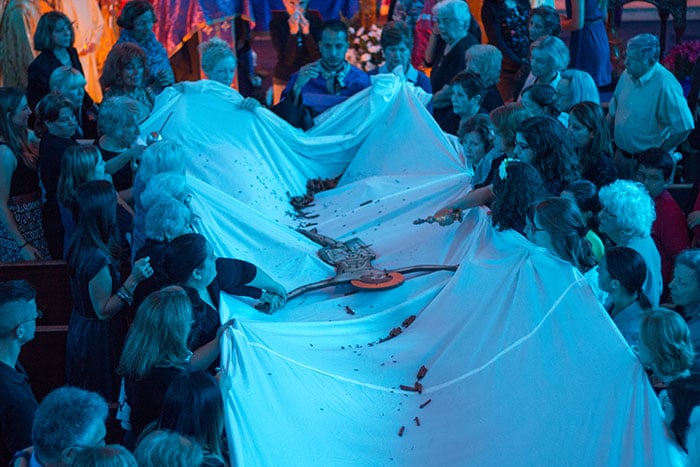 As the priest reads the Gospel, "and taking the body, Joseph wrapped it in a white cloth," he removes the Body of Christ from the Cross, wraps it in a white cloth and takes it to the altar. The priest then chants a mourning hymn: "When Joseph of Arimathea took Thee, the life of all, down from the Tree dead, he buried Thee with myrrh and fine linen . . . rejoicing. Glory to Thy humiliation, O Master, who clothest Thyself with light as it were with a garment." The priest then carries the cloth on which the Body of Christ is painted or embroidered around the church before placing it inside the Sepulcher, a carved bier which symbolizes the Tomb of Christ. We are reminded that during Christ's entombment He descends into Hades to free the dead of the ages before His Resurrection.
As the priest reads the Gospel, "and taking the body, Joseph wrapped it in a white cloth," he removes the Body of Christ from the Cross, wraps it in a white cloth and takes it to the altar. The priest then chants a mourning hymn: "When Joseph of Arimathea took Thee, the life of all, down from the Tree dead, he buried Thee with myrrh and fine linen . . . rejoicing. Glory to Thy humiliation, O Master, who clothest Thyself with light as it were with a garment." The priest then carries the cloth on which the Body of Christ is painted or embroidered around the church before placing it inside the Sepulcher, a carved bier which symbolizes the Tomb of Christ. We are reminded that during Christ's entombment He descends into Hades to free the dead of the ages before His Resurrection.
The Scripture readings for the Vespers are: Exodus 33:11-23; Job 42:12-17; Isaiah 52:13-54:1; I Corinthians 1:18-2:2; and from the Gospels Matthew 27:1-38; Luke 23:39-43; Matthew 27:39-54; John 19:31-37; and Matthew 27:55-61.
Hymns and Prayers for Great and Holy Friday
Fifteenth Antiphon of the Matins (Plagal of the Second Tone)
Today He who hung the earth upon the waters is hung upon the Cross. He who is King of the angels is arrayed in a crown of thorns. He who wraps the heavens in clouds is wrapped in the purple of mockery. He who in Jordan set Adam free receives blows upon His face. The Bridegroom of the Church is transfixed with nails. The Son of the Virgin is pierced with a spear. We venerate Thy Passion, O Christ. Show us also Thy glorious Resurrection.
Exapostelarion
On the same day, O Lord, You granted the Robber Paradise. Now by the wood of the Cross, illumine me and save me.
"Samo sloga Srbina spasava"
Click to download crest story.
"Only Unity Saves the Serbs"
My Parish
Local Area Churches and Clergy
Visiting
Video
Readings
Donate
Calendar
Mailing List
If you would like to join our mailing list, please fill out the following form.






